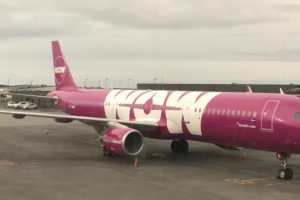7 Things You Need To Know About Low-Cost Airlines
Ultra-low-cost airlines (as opposed to legacy carriers such as American or United) are a lot of times the cheapest way to get from place to place. Low-cost carriers offer generally much cheaper fares than regular airlines and therefore make traveling for many people much more affordable. But what is the difference between regular airlines and low-cost carriers in terms of cost, are there any fees on low-cost carriers, and what is the service difference between the two types of airlines? Continue reading to find out answers to all of
So What Even Are Low-Cost Carriers?

Low-cost airlines are airlines that generally offer lower base ticket costs than conventional airlines such as Delta Air Lines, British Airways, or Qantas. This is because those airlines have lower operating costs (wages, amount of staff, etc.), fit more seats on planes, and have more onboard fees (I’ll talk about fees later on in this article). These airlines tend to operate mostly on short-haul routes using aircraft such as 737s or A320s although sometimes they also fly on longer routes. Most low-cost carriers have aircraft in a single economy class configuration, although some airlines also have a premium economy class cabin. Low-cost carriers are located in most major countries and make up a large percentage of commercial airlines throughout the world.
The Base Price That You See Will Be Cheaper…
First of all, by full-service airlines, I mean airlines such as Delta, ANA, Singapore Airlines, or Air France that have premium cabins and generally better in-flight services. The first thing that you should expect from a low-cost carrier is to have lower (sometimes much lower) prices than full-service airlines. For example, the base price of a flight from London to Rome on Ryanair (a low-cost carrier) is sometimes as low as $26 while most flights on British Airways or Alitalia (full-service airlines) are around $100 for a one-way flight. Or you could fly on Frontier Airlines from Denver to Los Angeles for $50 while most tickets on United, Delta, or American range from $100-$150 in economy. Or, you could fly from Hong Kong to Singapore on low-cost Scoot for $70 while it costs $250+ on that same route on Singapore Airlines.
The list of flights where low-cost airlines are cheaper than full-service airlines goes on and on. Low-cost airlines are able to have base prices much lower than most other airlines for one reason – most low-cost airlines operate on a business model that for the flight, they sell just the seat and if you want anything else, you will have to pay extra for it. That’s why low-cost airlines have so many fees beyond the base price, which I’ll discuss below.

…But You’ll Also Have A Lot Of Hidden Fees For Essentials You Need.
Most low-cost carriers (such as Ryanair, Wow Air, Frontier, Spirit, but not Southwest or JetBlue) make up for their exceedingly low prices with a lot of fees. Carry-on fees, baggage fees, food and drink fees (even for water!), check-in at the airport fees, seat selection fees, and fees for using the restroom (not really, although I wouldn’t be surprised if an airline eventually introduced that). As a comparison, most mainline airlines have baggage, seat selection, food and drink, and a carry-on included with the purchase price unless you purchase a basic economy seat. That can mean that on low-cost carriers, you pay $40 for the base price, although you pay $300 for baggage, a good seat, and a carry-on! If you do the math, a lot of times, full-service carriers can be cheaper than low-cost carriers even if the base price on the low-cost carrier is much lower origionally!
Tip: If you want to book a flight on a low-cost carrier, go through the booking process all the way until it is time to pay where then you would have selected all of the add-ons that you would want. Look at the price and then compare it to a full-service airline that has all of those extras that you want included. It very well may be that the full-service airline beats the low-cost airline by a lot!
Don’t Expect Much Comfort…
Most low-cost airlines have so-called slimline seats in economy class which are extremely thin. They are very light, can fit a lot of them on the plane, and usually aren’t that far apart from each other (you’ll have no legroom). For example, Spirit Airlines only has 28 inches of legroom in economy class, while most others have 30-32 in economy class. The legroom is so bad that SeatGuru marked all of the seats on their aircraft yellow because of the lack of legroom! Legroom is similarly awful on Allegiant, EasyJet, Ryanair, Jetstar, or Frontier. Also, since those slimline seats are so thin, it will almost feel like you are sitting on a hard rock for the entire flight.
Some of those airlines such as Spirit or Ryanair also don’t give any recline to any seats on the plane. Well, they call the seats “pre-reclined,” but that’s their marketing teams’ way of making a negative into a positive. On one particular seat model on Spirit, Frontier, and Allegiant, the tray tables are so small, that you can’t even fit a meal tray on it and is way too small even for an i-pad mini! So yeah, on those airlines, don’t expect to be able to do any computer work in-flight.
…Or Entertainment

While there are quite a few exceptions (Southwest, Azul, JetBlue), on most short-haul flights and on many long-haul flights, low-cost airlines don’t offer any sort of in-flight entertainment. This is because the prices are for the most part less expensive than full-service airlines that offer entertainment. For a low price, airlines aren’t willing to pay to get entertainment systems installed within aircraft as they do cost a lot of money. Notable airlines that don’t offer in-flight entertainment include Spirit, Allegiant, Frontier, Ryanair, Air Asia, Wizz Air, Indigo, Interjet, and many more. Please note that most low-cost airlines that operate on long-haul routes have some sort of in-flight entertainment (even if it’s just personal device entertainment) such as Level, Eurowings, Jetstar, or Norwegian, because even they know that long-haul flights without entertainment would be too brutal for most people of this modern world.
However, there are quite a few low-cost airlines that are continuing to develop and add personal device entertainment to aircraft in which you can stream content to one of your own devices. That is because it is cheaper than having physical screens and makes in-flight experiences much more enjoyable. Low-cost airlines that are bringing personal device entertainment to short-haul flights include Southwest, Scoot, WestJet, and Gol. JetBlue and Azul are two of the few low-cost airlines that have personal on-demand entertainment on their aircraft, even on short-haul flights.
But Premium Economy Is Sometimes A Deal

On long-haul flights, many low-cost carriers now offer a premium-economy cabin as opposed to just having an only economy class cabin. Such airlines include Norwegian, Scoot, Level, Eurowings, Tui, and Jetstar. These airlines use aircraft such as the 787 or the A330 to fly between business or travel hubs where their prices usually beat mainline airlines. However, an even better deal than in economy class would often be to upgrade to premium economy class.
For Example, Norwegian Air shuttle consistently has around $500 one way transatlantic fares in premium economy seats (pictured above), which sometimes is a better deal than in regular economy class on other airlines. Similarly, Scoot has fares around $650 on long-haul routes from Singapore to Berlin while premium economy fares on a route that length would normally be above $1,500. In premium economy on those airlines, one usually receives a higher baggage allowance, (sometimes) better and free food, and of course a better seat with a leg rest and a lot of recline. Overall, on a lot of low-cost long-haul airlines, premium economy is a great deal.

I wrote a whole article on it last summer, so I won’t talk about it much in this article again. At the front of all of Spirit Airlines’ aircraft, they have 4-12 “Big Front Seats” which have extra legroom and have first class seats. They are pretty comfortable (I flew in one 1.5 years ago) and come at an amazing price – they range from being $15 to in some rare cases over $100 more expensive than economy – a price that even economy plus sometimes can’t beat. No, you don’t get better service and the seats don’t even recline, but for such a cheap price, Spirit’s Big Front Seats really are still an amazing deal.
Lastly, Not All Low-Cost Carriers Are Created Equal
From what I wrote above, you might think that all low-cost airlines are the same. That is not the impression that I want to leave you with. Above, I mostly talked a lot the low-cost carriers with fees, no comfort, and have no entertainment. Those are the so-called ultra-low-cost airlines which have the cheapest base prices, but then nickel and dime you every other opportunity they get before, during, and after the flight. No, not all low-cost carriers are the same. On the one hand, you have those Spirit/Ryanair ultra-low-cost carriers.

Then, on the other hand, you have airlines such as JetBlue, Southwest, or Eurowings which have in-flight entertainment, (sometimes) a proper business class, not as many hidden fees, and with the only thing differentiating themselves from American or BA being their slightly lower fares. That’s why I like the so-called “light” low-cost carriers so much better – they offer cheap flights without sacrificing entertainment or comfort, and don’t try and manipulate their customers like airlines such as Frontier do with so many fees and surcharges.
Low-cost does not mean that they have unlimited fees and your back will be telling you never to fly that airline again after the flight because frankly not all low-cost airlines even are bad in terms of your in-flight experience. But I would go almost as far as to say that being an ultra-low-cost airline (unless you are traveling in Spirit’s Big Front Seats) does mean all of that, because – let’s face it – that basically is the definition of being an ultra-low-cost carrier.
Conclusion:
The main distinction between low-cost carriers and mainline carriers is that the low-cost airlines have much lower base prices than mainline airlines. That doesn’t mean that they, in the end, will be cheaper, but most of the time, they end up being at least a little bit cheaper. Mainline airlines are beginning to compete with the low prices by introducing either low-cost subsidiaries or by introducing basic economy (article coming soon about it) where you don’t get many of the in-flight services included. Overall, low-cost airlines have lower prices than most mainline airlines. However, that doesn’t necessarily mean your experience won’t be better than on one of the full-service airlines.
What do you think about low-cost airlines?




